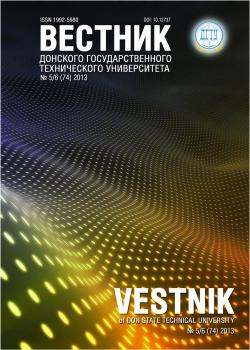The purpose of this study is to investigate the influence of the alcohol atomicity on the self-organizing control capability in order to achieve the wearlessness effect in the friction pair of steel-steel. The copper-containing lubricant compositions are prepared in the electrolysis of the aqueous solutions of polyatomic alcohols with a copper anode in the ultrasonic field (complex processing). The laboratory testing of the tribological behavior of the lubricating compositions is carried out on four-ball machine using balls of SH-15 steel according to GOST 9490-75. Tribological properties of steel-steel friction pair are studied on the front friction machine AE-5. The copper particle size is defined by the sedimentation analysis method using the disk centrifuge of CPS Disc Centrifuge Model DC24000 brand in the aqueous solutions of polyatomic alcohols. The topo-graphic studies of the nanocluster metal structures are performed with the scanning probe microscope (SPM) Solver P47H in the semi-contact mode of the atomic force microscopy (AFM). The topographic investigations of a servovit film are conducted with the use of the scanning atomic force and power microscope of Compact AFM PHYWE. It is shown that the time increment of the integrated processing of a water-alcohol mixture leads to the strengthening of the antiwear properties of lubricant compositions. Increasing alcohol atomicity facilitates the implementation of the selective transfer, thus reducing wear and the transition time in the wearlessness mode. The resulting molecular ligand copper clusters with an average size of 25 nm are characterized by high uniformity. Thus, the friction track represents rather ironed surface with low roughness.
copper nanoclusters, wearlessness, friction ratio, wear rate, atomic force microscopy.
Введение. Проблема повышения ресурса узлов трения машин и механизмов требует поиска новых эффективных пу-тей решения. В настоящее время динамично развивается изучение наноразмерных объектов и систем, которые прояв-ляют принципиально новые свойства и обладают огромным потенциалом использования в реальном секторе экономи-ки. Нанодисперсные частицы металлов имеют уникальные свойства, связанные с размерными эффектами. Благодаря
этому их применение при решении трибологических задач позволяет получить материалы с принципиально новыми
характеристиками [1–3]. Проведенные ранее исследования показали, что формирование квазикристаллической серво-витной пленки в паре трения сталь-сталь в водно-глицериновой среде, содержащей дисперсную фазу из наноразмер-ных частиц меди, происходит не только за счет трибовосстановительного распада имеющихся медьсодержащих со-единений, но и за счет переноса кластеров металла [4–7].
Данная работа продолжает изучение влияния молекулярного строения используемых в составе смазочного
материала органических компонентов [8–10]. При этом целью настоящего исследования является изучение триболо-гической эффективности медьсодержащих растворов многоатомных спиртов в паре трения сталь-сталь
1. Garkunov, D. N., Babel, V. G. Vliyanie metalloplakiruyushchikh prisadok na tribotekhnicheskie kharakteristiki plastichnoy smazki «Buksol». [Effect of metal plaque additives on tribological characteristics of “Buksol” lubricant.] Friction & Lubrication in Machines and Mechanisms, 2006, no. 7, pp. 20-25 (in Russian).
2. Luty, M., et al. Metodologiya sozdaniya smazochnykh materialov s nanomodifikatorami. [Methods of creating lu-bricating materials with nanomodifiers.] Friction and Wear, 2002, vol. 23, no. 4, pp. 411-423 (in Russian).
3. Kuzharov, A. S., et al. Triboelectrochemistry of the “warless” effect. Mechanism of the forming of the protective layers on steel surface in the process of self-organization in tribosystem “copper - glycerin - steel”. Friction and Wear, 1998, vol. 19, no. 6, pp. 768-778.
4. Kuzharov, А. А. Tribotekhnicheskie svoystva nanometrichnykh klasterov medi : dis. … kand. tekhn. nauk. [Tribo-logical properties of copper nanoclusters: Cand.Sci. (Eng.) diss.] Rostov-on-Don, 2004, 136 p. (in Russian).
5. Padgurskas, J., et al. Tribological properties of lubricant additives of Fe, Cu and Co nanoparticles. Tribologu In-ternational, 2013, vol. 60, no. 4, pp. 224-232.
6. Zhau, J., et al. Tribological behavior and lubricating mechanism of Cu nanoparticles in oil. Tribology Letters, 2000, vol. 8, no. 4, pp. 213-218.
7. Burlakova, V. E. Triboelektrokhimiya effekta bezyznosnosti. [Triboelectrochemistry of wearlessness effect.] Ros-tov-on-Don: DSTU Publ. Centre, 2005, 209 p. (in Russian).
8. Kuzharov, A. S., Burlakova, V. E., Kravchik, K. Triboelektrokhimicheskoe povedenie stali v sistematicheskom ryadu odnoatomnykh spirtov. [Triboelektrochemical behavior of steel in systematic series of monobasic alcohols.] Vestnik ofDSTU, 2004, vol. 4, no. 1 (19), pp. 47-54 (in Russian).
9. Kuzharov, А. А, Kosogova, Y. P., Kuzharov, A. S. Sintez i tribotekhnicheskie svoystva nanoklasterov medi v vodnykh rastvorakh sorbita. [Synthesis and tribological properties of copper nanoclusters in sorbitol aqueous solutions.] Vest-nik of DSTU, 2004, vol. 5, no. 4 (26), pp. 628-630 (in Russian).
10. Wan, Y., Liu, W., Xue, Q. Effects of diol compounds on the friction and wear of aluminum alloy in a lubricated aluminum-on-steel contact. Wear, 1996, vol. 193, pp. 99-104.
11. GOST 9490-75. Materialy smazochnye zhidkie i plastichnye. Metod opredeleniya tribologicheskikh kharakteris-tik na chetyrekhsharikovoy mashine. [GOST 9490-75. Liquid lubricating and plastic materials. Method of test for lubricating properties on four ball machine.] Ministry of oil refining and petrochemical industry of USSR; State Standards Board of the USSR Cabinet. Moscow: Izdatel´stvo standartov, 1987, 5 p. (in Russian).
12. Xu, Y., et al. Preparation and Tribological Properties of Surface-coated Nano-copper Additives. Key Engineering Materials, 2008, vol. 373/374, pp. 580-584.
13. Garkunov, D. N. Tribotekhnika (iznos i bezyznosnost´). [Triboengineering (wear and wearlessness).] Moscow: Izdatel´stvo MSKhA, 2001, 616 p. (in Russian).
14. Zolotukhina, L. V., et al. Formirovanie nanokristallicheskoy struktury na poverkhnostyakh treniya v prisutstvii na-noporoshkov splavov medi v smazochnom material. [Forming nano-crystalline structure on friction surfaces over а nano-powder of copper alloys in lubricant.] Friction & Lubrication in Machines and Mechanisms, 2007, no. 3, pp. 7-12 (in Russian).
15. Babichev, А. P., Ivanov, V. V., Burlakova, V. E. Issledovanie mikro / nanoprofilya tsinkovogo pokrytiya pri vi-bratsionnoy mekhanokhimicheskoy obrabotke uglerodistykh staley. [Research of micro/nanoprofile zinc coating with vibration mechanochemical treatment carbon steels.] Strengthening Technologies and Coatings, 2014, no. 7 (115), pp. 46-48 (in Rus-sian).
16. Kosogova, Y. P. Nanotriboelektrokhimicheskie tekhnologii pri realizatsii effekta bezyznosnosti v vodno-spirtovykh sredakh : avtoref. dis. … kand. tekhn. nauk [Nanotriboelectrochemical technologies during the implementation of wearlessness effect in aqueous-alcoholic media: Cand.Sci. (Eng.) diss., author’s abstract.] Rostov-on-Don, 2009, 23 p. (in Russian).





